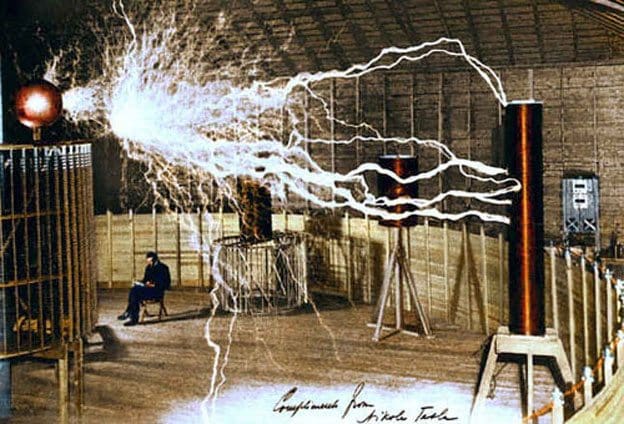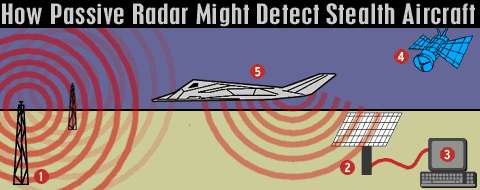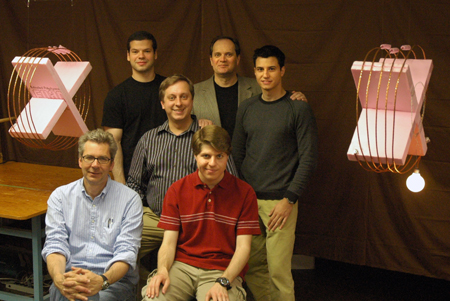Tesla investigated harvesting energy from the air. He believed that it was merely a question of time until men would succeed in attaching their machinery to the very wheelwork of nature, stating: "Ere many generations pass, our machinery will be driven by a power obtainable at any point of the universe."
 At the Columbian Exposition, Tesla demonstrated a series of electrical effects in a lecture he had performed throughout America and Europe. This included using high-voltage, high-frequency alternating current to light a wireless gas-discharge lamp. Tesla's theories on the possibility of the transmission by radio waves go back as far lectures and demonstrations in 1893 in St. Louis, Missouri, the Franklin Institute in Philadelphia, Pennsylvania, and the National Electric Light Association. Tesla's demonstrations and principles were written about widely through various media outlets. Many devices such as the Tesla Coil were used in the further development of radio. Tesla's radio wave experiments in 1896 were conducted in Gerlach Hotel (later renamed The Radio Wave building), where he resided.
At the Columbian Exposition, Tesla demonstrated a series of electrical effects in a lecture he had performed throughout America and Europe. This included using high-voltage, high-frequency alternating current to light a wireless gas-discharge lamp. Tesla's theories on the possibility of the transmission by radio waves go back as far lectures and demonstrations in 1893 in St. Louis, Missouri, the Franklin Institute in Philadelphia, Pennsylvania, and the National Electric Light Association. Tesla's demonstrations and principles were written about widely through various media outlets. Many devices such as the Tesla Coil were used in the further development of radio. Tesla's radio wave experiments in 1896 were conducted in Gerlach Hotel (later renamed The Radio Wave building), where he resided.
In 1899 Tesla performed experiments in the field of pulsed wireless energy transfer. Tesla’s Magnifying Transmitter, an early type of Tesla Coil that measured 16 meters in diameter, was able to transmit tens of thousands of watts without wires. In 1897, he filed his first patents dealing with Wardenclyffe tower. This tower was supposed be a pilot plant for his “World Wireless System” to broadcast energy around the globe. But he was not able to make it fully operational due to economic problems.
The Raytheon Company performed the first successful WPT (Wireless Power Transmission) experiment in 1963. During that experiment energy was transmitted with a DC-to-DC efficiency of 13%. In1975 the Jet propulsion lab of NASA carried out an experiment and demonstrated the transfer of 30 kW over a distance of 1 mile using an antenna array erected at the Goldstone facility. This test proved the possibilities of wireless power outside the laboratory. Rockwell International and David Sarnoff Laboratory operated in 1991 a microwave powered rover at 5.86 GHz.
Three kilowatts of power was transmitted and 500 watts was received. Electricity is needed to be transformed into a suitable energy form for its transportation. For wireless transmission, this has to be a form that can travel trough air. Microwave frequencies hold this ability. The microwave spectrum is defined as electromagnetic energy ranging from approximately 1 GHz to 1000 GHz in frequency, but older usage includes lower frequencies. Most common applications are within the 1 to 40 GHz range.
One of the disadvantages is that microwaves have long wavelengths that exhibit a moderate amount of diffraction over long distances. The Rayleigh criterion dictates that any beam will spread (microwave or laser), become weaker, and diffuse over distance. The larger the transmitter antenna or laser aperture, the tighter the beam and the less it will spread as a function of distance (and vice versa). Therefore, the system requires large transmitters and receivers. The used power density of the microwave beam is normally in the order of 100 W/m2. This is relative low compared to the power density of solar radiation on earth (1000 W/m2) and chosen this way for safety reasons.
Alternatively radio transmissions in the form of data other then music or audio signals became popular. The set of standards for implementing wireless local area network (WLAN) computer communication in the 2.4, 3.6 and 5 GHz frequency bands commonly known as EEE 802.11. 802.11 technology has its origins in a 1985 ruling by the US Federal Communications Commission that released the ISM band for unlicensed use. In 1991, NCR Corporation with AT and T Corporation invented the precursor to 802.11 intended for use in cashier systems. The first wireless products were under the name WaveLAN. Vic Hayes has been called the "father of Wi-Fi" by some, due to his involvement in negotiating the initial standards within the IEEE while chairing the work-group.
A large number of patents by many companies are used in 802.11 standard. In 1992 and 1996, Australian organization CSIRO obtained patents for a method later used in Wi-Fi to "unsmear" the signal. In April 2009, 14 tech companies agreed to pay CSIRO $250 million for infringements on CSIRO patents. This led to WiFi being attributed as an Australian invention, though this has been the subject of some controversy. CSIRO won a further $220 million settlement for Wi-Fi patent infringements in 2012 with global firms in the United States required to pay the CSIRO licensing rights estimated to be worth an additional $1 billion in royalties. In 1999, the Wi-Fi Alliance was formed as a trade association to hold the Wi-Fi trademark under which most products are sold. The key technologies behind Wi-Fi were developed by the radioastronomer John O'Sullivan as a by-product in a research project, "a failed experiment to detect exploding mini black holes the size of an atomic particle".
WiMAX operates on the same general principles as WiFi -- it sends data from one computer to another via radio signals. A computer (either a desktop or a laptop) equipped with WiMAX would receive data from the WiMAX transmitting station, probably using encrypted data keys to prevent unauthorized users from stealing access.
The fastest WiFi connection can transmit up to 54 megabits per second under optimal conditions. WiMAX should be able to handle up to 70 megabits per second. Even once that 70 megabits is split up between several dozen businesses or a few hundred home users, it will provide at least the equivalent of cable-modem transfer rates to each user. The biggest difference isn't speed; it's distance. WiMAX outdistances WiFi by miles. WiFi's range is about 100 feet (30 m). WiMAX will blanket a radius of 30 miles (50 km) with wireless access. The increased range is due to the frequencies used and the power of the transmitter. Of course, at that distance, terrain, weather and large buildings will act to reduce the maximum range in some circumstances, but the potential is there to cover huge tracts of land.
Signal transmission at in the microwave range from existing transmitters offers a radio source for a passive radar system. These systems are used in a variety of settings, and they have a number of benefits which make them targets of interest for many military technology developers. Essentially, a passive radar is a very finely tuned pair of ears, sensitive to high frequency radio waves rather than sounds which can be heard by the human ear. Many people are familiar with the way in which radar works:
A signal is transmitted, and a receiver waits for the signal to return, drawing inferences from the returned signal about what kind of objects the signal interacted with, and how far away they are. For example, a ship could use radar to look for potential enemy ships in the area. Unlike sonar, which uses sound, radar uses high frequency radio waves. Passive radar has the same ability to pick up microwave energy, but it does not transmit it. Instead, is uses reflections from other objects and the original source to gather information about targets, working passively rather than actively to identify objects in its vicinity. Using this information, the device can provide information about range, velocity, and location which can be used to make decisions. Passive radar on an aircraft, for instance, might be used to identify other aircraft in the area for the purpose of avoiding them. Using computational power to analyze small incoming signal disturbances, its possible to track speed, direction and possibly size.
British engineers from University College London have developed a passive radar system that can see through walls using the WiFi signals generated by wireless routers and access points. The system, devised by Karl Woodbridge and Kevin Chetty, requires two antennae and a signal processing unit (i.e. computer), and is no larger than a suitcase. Unlike normal radar, which emits radio waves and then measures any reflected signals, this new system operates in complete stealth.
The natural evolution of cordless toothbrushes and power mat chargers have progressed to the possible idea of wireless transmission within the home
Invented by Marin Soljacic from MIT, the technique can power an entire room, assuming the room is filled with devices capable to receive the wireless power. Unlike the products from the competition, charging station and charging devices don’t have to be close to each other in order to transfer energy. Instead, they depend on so-called magnetic resonance. Like acoustical resonance, which allows an opera singer to break a glass across the room by vibrating it with the correct frequency of the voice’s sound waves, magnetic resonance can launch an energetic response in something far away.











No comments:
Post a Comment